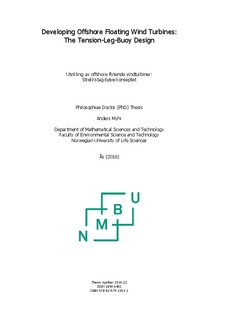| dc.description.abstract | A 5 MW Tension-Leg-Buoy (TLB) concept has been optimized and developed. The design is based on the MIT Double Taut Leg, initially proposed by Professor Sclavounos of MIT in 2005. Six variants have been tested, in two wave tank tests, to prove the concept and aid validation of 3DFloat, the coupled aero-hydro-servo-elastic tool utilized for the numerical computations. Optimized TLB designs are presented in this thesis for harsh weather sites in the North Sea basin, and a new TLB design (designated TLB B2) for the K13 Deep water site in the Dutch North Sea.
The TLB concept relies on inclined taut synthetic fibre mooring lines and excess buoyancy for stability. Thus, its natural resonance (Eigen) periods must be shorter than wave periods in the high energy part of the wave spectrum, i.e. less than 3.5 seconds. Ensuring that none of the Eigen-periods interfere with the rotor rotational periods then becomes challenging and requires a sophisticated optimization approach. Due to low damping, the structure is prone to resonant behaviour and fatigue becomes important. Fatigue damage is particularly high when the rotor is in idle or parked mode and the aerodynamic damping contribution is low. However, even when accounting for fatigue, the resulting need for primary steel in the construction is low. The TLB B2 design has a draft of 40 m and buoyancy of 2166 tons. The total mass is 1068 tons, of which the floater accounts for only 355 tons. The remaining mass origin from the 350-ton nacelle assembly and the 363 tons of tower structure.
Due to the strong influence of Eigen-periods, the design is sensitive to site conditions, especially water depth and environmental conditions. It is therefore challenging to develop a straightforward strategy to determine its potential at a given site. A specific design approach has therefore been developed and the validity of a two-stage optimization procedure (frequency-domain followed by time-domain optimization) is presented. The approach is verified by Ultimate-, Accidental, and Fatigue Limit state analyses.
The design approach features a cost evaluation in a Levelised Cost of Energy perspective (LCOE) and the concept’s performance parameters are compared to those of various floating turbine concepts, bottom-fixed monopiles and jacket structures. In terms of capital expenditure (CAPEX), TLB B2 is the optimal concept for the K13 site, low material and production costs providing a significant advantage. The combined CAPEX of production and mooring is significantly lower than the production cost alone for both jacket and monopile foundations. In terms of LCOE, at about € 107 per MWh over a lifetime of 25 years, the TLB B2 is comparable to monopile foundations in an optimal depth (around 15 m) of water. The relative variation of the concepts’ LCOE is assumed to be 7% and 8 %, respectively.
In comparison to previous TLB designs, the TLB B2 design substructure mass is 19 % lower, and the anchor loads are 47 % lower. The mooring loads are comparable to those of typical catenary mooring systems.
The work presented in the thesis shows that TLB designs can potentially provide simple and economically advantageous options for supplying green energy in intermediate water depths of 50 to 100 m and should therefore be pursued further. | nb_NO |

